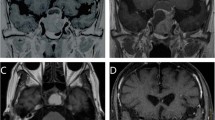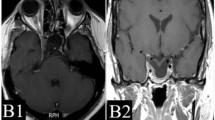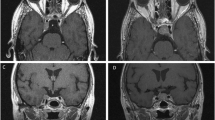Abstract
Complete surgical removal of non-functioning pituitary adenomas is often not possible. This retrospective study aimed at evaluating the long-term outcome and complications of Gamma Knife (GK) radiosurgery adjuvant to pituitary microsurgery in selected patients with small tumour remnants treated 1994–2004. Thirteen men and ten women, median age 49 years, were identified. Prior to GK 15 patients had remaining pituitary function. Median size of the tumours was 1.1 cm3. Median marginal dose was 20 Gy. Median follow-up with MR imaging was 78 and 97 months for clinical evaluation. Tumour growth control was 100%, irrespectively of growth hormone (GH) therapy for 72 months (n = 10). Only one recurrence was discovered outside radiation field and no new hypopituitarism was developed. This report suggests that in well-selected patients the long-term risk of complications is low and with careful surveillance GH insufficiency can be replaced. Lifelong follow-up is mandatory.


Similar content being viewed by others
References
Sheehan JP, Kondziolka D, Flikinger J, Lunsford LD (2002) Radiosurgery for residual or recurrent non-functioning pituitary adenoma. J Neurosurg 97:408–414
Laws ER, Sheehan JP, Sheehan JM, Jagnathan J, Jane JA Jr, Oskouian R (2004) Stereotactic radiosurgery for pituitary adenomas: a review of the literature. J Neurooncol 69:257–272. doi:10.1023/B:NEON.0000041887.51906.b7
Greenman Y, Ouaknine G, Veshchev I, Reidar-Groswasser I, Segev Y, Stern N (2003) Postoperative surveillance of clinically non-functioning pituitary macroadenomas: markers of tumour quiescence and regrowth. Clin Endocrinol (Oxford) 58:763–769. doi:10.1046/j.1365-2265.2003.01784.x
Kong DS, Lee JI, Lim DH, Kim KW, Shin HJ, Nam DH, Park K, Kim JH (2007) The efficacy of fractionated radiotherapy and stereotactic radiosurgery for pituitary adenomas. Cancer 110:854–860. doi:10.1002/cncr.22860
Thorén M, Höybye C, Grenbäck E, Degerblad M, Rähn T, Hulting AL (2001) The role of Gamma Knife radiosurgery in the management of pituitary adenomas. J Neurooncol 54:197–203. doi:10.1023/A:1012926022229
Becker G, Kocher M, Kortmann RD, Paulsen F, Jeremic B, Müller RP, Bamberg M (2002) Radiation therapy in the multimodal treatment approach of pituitary adenoma. Strahlenther Onkol 4:173–186. doi:10.1007/s00066-002-0826-x
Marcou Y, Plowman PN (2000) Stereotactic radiosurgery for pituitary adenomas. Trends Endocrinol Metab 11:132–137. doi:10.1016/S1043-2760(00)00242-3
Wowra B, Stummer W (2002) Efficacy of Gamma Knife radiosurgery for non-functioning pituitary adenomas: a quantitative follow up with magnetic resonance imaging-based volumetric analysis. J Neurosurg 97:429–432
Muacevic A, Uhl E, Wowra B (2004) Gamma Knife radiosurgery for non-functioning pituitary adenomas. Acta Neurochir (Wien) 91(Suppl):51–54
Kuo JS, Chen JC, Yu C, Zelman V, Gianotta SL, Petrovich Z, MacPherson D, Apuzzo ML (2004) Gamma Knife radiosurgery for benign cavernous sinus tumors: quantitative analysis of treatment outcomes. Neurosurgery 54:1385–1393. doi:10.1227/01.NEU.0000124750.13721.94
Minniti G, Traish D, Ashley S, Gonsalves A, Brada M (2006) Fractionated stereotactic conformal radiotherapy for secreting and nonsecreting pituitary adenomas. Clin Endocrinol (Oxford) 64:542–548. doi:10.1111/j.1365-2265.2006.02506.x
Picozzi P, Losa M, Mortini P, Valle MA, Franzin A, Attuati L, Ferrari da Passano C, Giovanelli M (2005) Radiosurgery and the prevention of regrowth of incompletely removed non-functioning pituitary adenomas. J Neurosurg 102(Suppl):71–74
Liscak R, Vladyka V, Marek J, Simonova G, Vymazal J (2007) Gamma Knife radiosurgery for endocrine-inactive pituitary adenomas. Acta Neurochir (Wien) 149:999–1006. doi:10.1007/s00701-007-1253-7
Pollock BE, Cochran J, Natt N, Brown PD, Erickson D, Link MJ, Garces YI, Foote RL, Stafford SL, Schomberg PJ (2008) Gamma Knife radiosurgery for patients with non-functioning pituitary adenomas: results from a 15 years experience. Int J Radiat Oncol Biol Phys 70:1325–1329. doi:10.1016/j.ijrobp.2007.08.018
Rosén T, Edén S, Larsson G, Wilhelmsen L, Bengtsson BÅ (1993) Cardiovascular risk factors in adult patients with growth hormone deficiency. Acta Endocrinol (Copenhagen) 129:195–200
Bulow B, Hagmar L, Mikoczy Z, Nordström CH, Erfurth EM (1997) Increased cardiovascular mortality in patients with hypopituitarism. Clin Endocrinol (Oxford) 46:75–81. doi:10.1046/j.1365-2265.1997.d01-1749.x
Verhelst J, Abs R (2002) Long-term growth hormone replacement therapy in hypopituitary adults. Drugs 62:2399–2412. doi:10.2165/00003495-200262160-00006
Monson JP (2003) Long-term experience with GH replacement therapy: efficacy and safety. Eur J Endocrinol 148:S9–S14. doi:10.1530/eje.0.148S009
Dekkers OM, Pereira AM, Romijn JA (2008) Treatment and follow-up of clinically nonfunctioning pituitary macroadenomas. J Clin Endocrinol Metab 93:3717–3726. doi:10.1210/jc.2008-0643
Rowe J, Grainger A, Walton B, Silcocks P, Radatz M (2007) Kemeny. Risk of malignancy after Gamma Knife stereotactic radiosurgery. Neurosurgery 60:60–65
Höybye C, Grenbäck E, Degerblad M, Rähn T, Thorén M, Hulting AL (2001) Adrenocorticotropic Hormone-producing Pituitary Tumors: 12–22 years follow-up after treatment with stereotactic radiosurgery. Neurosurgery 49:284–291. doi:10.1097/00006123-200108000-00008
Acknowledgments
This study was supported by grants from Pfizer AB and from Karolinska Institute.
Author information
Authors and Affiliations
Corresponding author
Rights and permissions
About this article
Cite this article
Höybye, C., Rähn, T. Adjuvant Gamma Knife radiosurgery in non-functioning pituitary adenomas; low risk of long-term complications in selected patients. Pituitary 12, 211–216 (2009). https://doi.org/10.1007/s11102-008-0163-x
Published:
Issue Date:
DOI: https://doi.org/10.1007/s11102-008-0163-x




